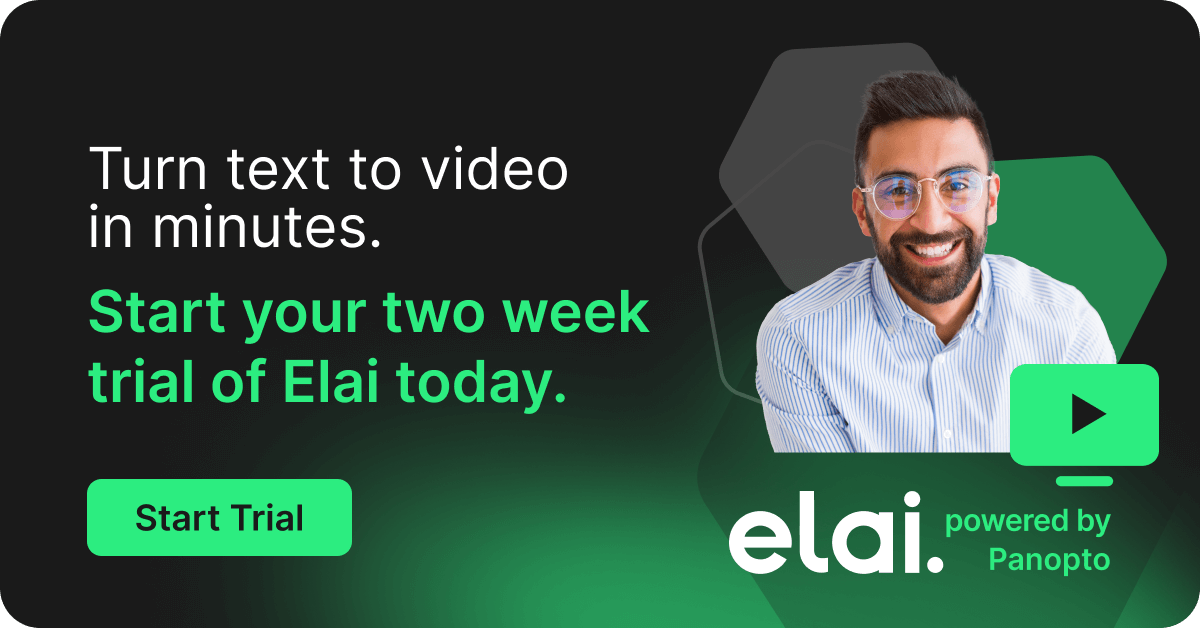- Uncategorized
Taking inspiration from the Panopto Conference for my next experiment with video
 I recently chaired a panel discussion at the Panopto Conference which featured several academics talking in-depth about their use of video for teaching and learning. This panel – along with many of the other conference sessions that took place throughout the day – was really interesting to me, as everyone was using video in such different ways. I came back fired with enthusiasm and inspired to continue experimenting with Panopto.
I recently chaired a panel discussion at the Panopto Conference which featured several academics talking in-depth about their use of video for teaching and learning. This panel – along with many of the other conference sessions that took place throughout the day – was really interesting to me, as everyone was using video in such different ways. I came back fired with enthusiasm and inspired to continue experimenting with Panopto.
One of the things that particularly caught my imagination was a conversation I had in preparation for the conference panel with Dr Daniel Moore, who has written previously on this blog about his use of video to deliver student feedback. I thought this was a great idea and one that I could start using at my university too. Our Admin office is full of marked scripts and assignments that simply remain uncollected and I think that many of my students would benefit from engaging more actively with their feedback to improve their results. I spend a lot of time writing comments about a student’s writing style, their use of referencing, how their content can be improved and where there is a mismatch against the marking criteria and their work. Yet students, once they have their mark, rarely seek me out to find out how to improve. There is a general feeling that if students made better use of the feedback we give them, then they would gain higher marks by addressing their weaknesses, building on their strengths and by not making the same mistakes over and over again.
The question, of course, is how to get students to engage in this active way and I think video offers a really effective means of doing this.
As a University lecturer, my main target audience is students who fall into the Generation Y and Z bracket – and they are the biggest consumers of video. They are also digital natives and will pull information to them when it is needed. By using video as a core communications medium, lecture content is available in a time-flexible format for students to access whenever they most need it. If I look at my Panopto stats, there is often a blip of activity around 11pm – 1am, which would suggest that this is the time that students are revising or revisiting material for assignments. But regardless of trends in video usage, one of the main advantages is that content doesn’t have to be consumed at this time – students can review first thing in the morning or later in the afternoon if that works better for them. From a practical, teaching perspective, video also makes things easier for me as it drastically cuts down on email traffic around assessment. I can simply refer students to relevant sections on the video recordings, which usually answers most of their questions!
I’ve actually been using video as part of my teaching for many years. I began in 2007, when I used to capture my lectures and then map these recordings to my lecture slides using a rudimentary software tool. A year later, I presented the findings from this mini research project on the effectiveness of lecture capture at the BMAF conference in Edinburgh. The experiences I outlined at the BMAF Conference 2008 showed that with large, diverse student cohorts, video is a perfect medium for getting across a consistent message that can be revisited after the physical lecture has finished.
Over subsequent years, I have developed my approach to video further and embraced new uses for video in the classroom. In addition to standard lecture capture, I also now create ‘micro lectures’ on various aspects of marketing strategy, for instance, on strategic options for market leaders. More recently, I have done video ‘pencasts’ on theoretical marketing models, such as Ansoff’s matrix, using the ‘capture primary screen’ facility on Panopto and running on a Smartboard. I think this is a real bonus for academics who don’t embrace the concept of being filmed, as it purely records voice and what’s on the screen. It’s a fantastic tool for conveying how theoretical models are built, step-by-step.
I have also used video to power the flipped classroom. My students have commented that by being able to watch videos in advance of class, they come to the face-to-face session with a better understanding of the subject and an ability to discuss it more fully.
Having been inspired by Dr Moore’s use of video feedback, and hearing more about the University of Derby’s Flexible Feedback project at the Panopto Conference, my first step towards implementing a similar approach at the University of Chichester was to record an assignment brief. I used a student submission from the previous academic year and gave video feedback on this, both to show how to correctly lay out an academic assignment and to outline where the student lost marks.
My plan is to build on this to start marking new student assignment submissions using video. So, I will record as I am marking, pausing while I enter the student’s score per section onto the mark sheet but recording both my written and audio comments. I will then make the video available to the student in a confidential area on Moodle and ask the student to mark it themselves using the marking criteria and send me their mark. Once they have done this, I will reveal my mark and compare the differences. I have already carried out a dry run of the process, by getting students to mark some of last year’s scripts, using the marking criteria. It was interesting to see that their marking was very accurate and so I actually don’t think there will be too many disparities when we run the project for real.
While I anticipate that the students’ marks and my own will be very similar, there are likely to be various other surprises (on both sides!) along the way. For instance, when I initially videoed the assignment brief and shared my marking process for the first time, many students hadn’t realised that I always start with the bibliography to see what resources they’ve used to complete their assignment. This has dramatically changed the standard of the scripts that I am currently marking, as the bibliographies are already much richer and the content is therefore far more informed. Of course, I have been telling students that this is how I mark for years but this is the first year that I have seen such a quantum leap in the quality of student assignments, so I think there is something about seeing the process on a recording that has really helped the message to sink in!
Given that the quality of student’s work is already improving, I think they will be very positive about this new development. I’m going to be surveying students to get a better picture of their views on the project, so we’ll get feedback on the feedback very soon!
If your institution wants to use video to enhance student feedback, flip the classroom, create ‘micro lectures’ or record lecture content, talk to the Panopto team to schedule an online demo and set up a free trial.




